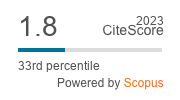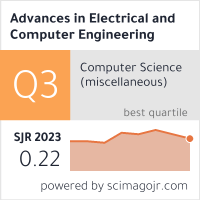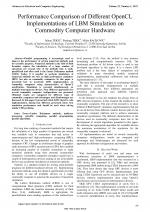| 1/2022 - 8 |
Performance Comparison of Different OpenCL Implementations of LBM Simulation on Commodity Computer HardwareTEKIC, J. |
| View the paper record and citations in |
| Click to see author's profile in |
| Download PDF |
Author keywords
Lattice Boltzmann methods, multicore processing, scientific computing, parallel programming, parallel algorithms
References keywords
boltzmann(25), lattice(24), method(13), flow(9), multi(8), flows(7), opencl(6), implementation(6), fluid(6), cavity(6)
Blue keywords are present in both the references section and the paper title.
About this article
Date of Publication: 2022-02-28
Volume 22, Issue 1, Year 2022, On page(s): 69 - 76
ISSN: 1582-7445, e-ISSN: 1844-7600
Digital Object Identifier: 10.4316/AECE.2022.01008
Web of Science Accession Number: 000762769600007
SCOPUS ID: 85126816356
Abstract
Parallel programming is increasingly used to improve the performance of solving numerical methods used for scientific purposes. Numerical methods in the field of fluid dynamics require the calculation of a large number of operations per second. One of the methods that is easily parallelized and often used is the Lattice Boltzmann method (LBM). Today, it is possible to perform simulations of numerical methods not only on high performance computers (HPC) but also on commodity computers. In this paper is presented how to accelerate LBM implementation on commodity computers using characteristics of OpenCL specification. Simulation is executed simultaneously on multiple heterogeneous devices. Four different approaches for several commodity computer configurations are presented. Obtained results are compared for different types of commodity computers and advantages and disadvantages are discussed. In this paper it presented which LBM OpenCL code implementation, among four different presented, shows best simulation performance and should be used when solving similar CFD problems. |
| References | | | Cited By «-- Click to see who has cited this paper |
| [1] P. L. Alvarez, S. Yamagiwa, "Invitation to OpenCL (Published Conference Proceedings style)," in Proc. Conference: Second International Conference on Networking and Computing, ICNC 2011, Osaka, Japan, November 30 - December 2, 2011, pp. 8-16. [CrossRef] [SCOPUS Times Cited 2] [2] W. S. R. M. Weiping Shi, "Finite-difference-based Lattice Boltzmann method for inviscid compressible flows," Numerical Heat Transfer, Part B: Fundamentals, vol. 40, pp. 1-21, no. 1, 2001. [CrossRef] [Web of Science Times Cited 64] [SCOPUS Times Cited 65] [3] R. Mei, W. Shyy, D. Yu, L.-S. Luo, "Lattice Boltzmann method for 3-D flows with curved boundary," Journal of Computational Physics, vol. 161, pp. 680-699, no. 2, 2000. [CrossRef] [Web of Science Times Cited 272] [SCOPUS Times Cited 313] [4] Z. Guo, T. S. Zhao, "A Lattice Boltzmann model for convective heat transfer in porous media," Numerical Heat Transfer, Part B: Fundamentals, vol. 47, pp. 157-177, no. 2, 2005. [CrossRef] [Web of Science Times Cited 255] [SCOPUS Times Cited 287] [5] P. M. Tekic, J. B. Radenovic, N. Lj. Lukic., S. S. Popovic, "Lattice Boltzmann simulation of two-sided lid-driven flow in a staggered cavity," Int. J. Comput. Fluid Dyn., vol. 24, pp. 383-390, no. 9, 2010. [CrossRef] [Web of Science Times Cited 11] [SCOPUS Times Cited 17] [6] N. Lukic,, P. Tekic, J. Radjenovic, I. Sijacki, "Lattice Boltzmann simulation of two-sided lid-driven flow in deep cavities," Acta Periodica Technologica, pp. 157-168, 2015. [CrossRef] [SCOPUS Times Cited 1] [7] S. Tomov, M. McGuigan, R. Bennett, G. Smith, J. Spiletic, "Benchmarking and implementation of probability-based simulations on programmable graphics cards," Computers & Graphics, vol. 29, pp. 71-80, no. 1, 2005. [CrossRef] [Web of Science Times Cited 31] [SCOPUS Times Cited 45] [8] W. Li, X. Wei, A. Kaufman, "Implementing lattice Boltzmann computation on graphics hardware," The Visual Computer, vol. 19, pp. 444-456, no. 7, 2003. [CrossRef] [Web of Science Times Cited 112] [SCOPUS Times Cited 152] [9] D. Vidal, R. Roy, F. Bertrand, "A parallel workload balanced and memory efficient Lattice-Boltzmann algorithm with single unit BGK relaxation time for laminar Newtonian flows," Computers & Fluids, vol. 39, pp. 1411-1423, no. 8, 2010. [CrossRef] [Web of Science Times Cited 112] [SCOPUS Times Cited 152] [10] K. Mattila, J. Hyvaluoma, J. Timonen, T. Rossi, "Comparison of implementations of the Lattice-Boltzmann method," Computers & Mathematics with Applications, vol. 55, pp. 1514-1524, no. 7, 2008. [CrossRef] [Web of Science Times Cited 46] [SCOPUS Times Cited 61] [11] G. K. Batchelor, "On steady laminar flow with closed streamlines at large Reynolds number," Journal of Fluid Mechanics, vol 1, pp. 177-190 , 1956. [CrossRef] [SCOPUS Times Cited 492] [12] F. Pan, A, Acrivos, "Steady flows in rectangular cavitie," Journal of Fluid Mechanics," vol. 28, pp. 643-655, 1967 [CrossRef] [SCOPUS Times Cited 400] [13] A. S. Benjamin, V. E. Denny, "On the convergence of numerical solutions for 2-D flows in a cavity at large Re," Journal of Computational Physics, vol. 33, pp. 340-358, 1979. [CrossRef] [Web of Science Times Cited 84] [SCOPUS Times Cited 96] [14] P. N. Shankar, M. D. Deshpande, "Fluid Mechanics in the Driven Cavity," Annual Review of Fluid Mechanics, vol. 32, no.1 , pp. 93-136, 2000. [CrossRef] [Web of Science Times Cited 624] [SCOPUS Times Cited 713] [15] C.-H. Bruneau, M. Saad, "The 2D lid-driven cavity problem revisited. Computers & Fluids," vol. 35, no. 3, pp. 326-348, 2006. [CrossRef] [Web of Science Times Cited 337] [SCOPUS Times Cited 397] [16] J. Tolke, "Implementation of a Lattice Boltzmann kernel using the Compute Unified Device Architecture developed by NVIDIA," Computing and Visualization in Science, vol. 13, no. 29, 2010. [CrossRef] [Web of Science Times Cited 138] [SCOPUS Times Cited 179] [17] C. Obrecht, F. Kuznik, B. Tourancheau, J.-J. Roux, "Multi-GPU implementation of the Lattice Boltzmann method," Computers & Mathematics with Applications, vol. 65, pp. 252-261, no. 2, 2013. [CrossRef] [Web of Science Times Cited 87] [SCOPUS Times Cited 102] [18] H.-W. Chang, P.-Y. Hong, L.-S. Lin, C.-A. Lin, "Simulations of three-dimensional cavity flows with multi relaxation time Lattice Boltzmann method and graphic processing units," Procedia Engineering, vol. 61, pp. 94-99, no. 2013. [CrossRef] [SCOPUS Times Cited 5] [19] H.-W. Chang, P.-Y. Hong, L.-S. Lin, C.-A. Lin, "Simulations of flow instability in three dimensional deep cavities with multi relaxation time Lattice Boltzmann method on graphic processing units," Computers & Fluids, vol. 88, pp. 866-871, no. 2013. [CrossRef] [Web of Science Times Cited 20] [SCOPUS Times Cited 22] [20] C. Huang, B. Shi, N. He, Z. Chai, "Implementation of Multi-GPU based Lattice Boltzmann method for flow through porous media," Advances in Applied Mathematics and Mechanics, vol. 7, pp. 1-12, no. 1, 2015. [CrossRef] [Web of Science Times Cited 36] [SCOPUS Times Cited 28] [21] P.-Y. Hong, L.-M. Huang, L.-S. Lin, C.-A. Lin, "Scalable multi-relaxation-time Lattice Boltzmann simulations on multi-GPU cluster," Computers & Fluids, vol. 110, pp. 1-8, no. 2015. [CrossRef] [Web of Science Times Cited 34] [SCOPUS Times Cited 36] [22] W. Xian, A. Takayuki, "Multi-GPU performance of incompressible flow computation by Lattice Boltzmann method on GPU cluster," Parallel Computing, vol. 37, pp. 521-535, no. 9, 2011. [CrossRef] [Web of Science Times Cited 121] [SCOPUS Times Cited 157] [23] B. Massimo, F. Massimiliano, M. Simone, S. Sauro, K. Efthimios, "A flexible high-performance Lattice Boltzmann GPU code for the simulations of fluid flows in complex geometries," Concurrency and Computation: Practice and Experience, vol. 22, pp. 1-14, no. 1, 2010. [CrossRef] [24] P. M. Tekic, J. B. Radjenovic, M. Rackovic, "Implementation of the Lattice Boltzmann Method on heterogeneous hardware and platforms using OpenCL, " Advances in Electrical and Computer Engineering, vol. 12, no. 1, pp. 51-56, 2012. [CrossRef] [Full Text] [Web of Science Times Cited 5] [SCOPUS Times Cited 6] [25] E. Calore, S.F. Schifano, R. Tripiccione, "A Portable OpenCL Lattice Boltzmann code for multi- and many-core processor architectures," Procedia Computer Science, vol. 29, pp. 40-49, 2014. [CrossRef] [Web of Science Times Cited 12] [SCOPUS Times Cited 13] [26] S. McIntosh-Smith, D. Curran, "Evaluation of a performance portable Lattice Boltzmann code using OpenCL," in Proc. Conference: International Workshop on OpenCL 2013 & 2014. Association for Computing Machinery, New York, NY, USA, 2014. [CrossRef] [SCOPUS Times Cited 4] [27] J. B. Tekic, P. M. Tekic, M. Rackovic, "Lattice Boltzmann method implementation on multiple devices using OpenCL," Advances in Electrical and Computer Engineering, vol. 3, pp. 3-8, 2018. [CrossRef] [Full Text] [Web of Science Times Cited 2] [SCOPUS Times Cited 2] [28] D. V. Patil, K. N. Lakshmisha, B. Rogg, "Lattice Boltzmann simulation of lid-driven flow in deep cavities," Computers & Fluids, vol. 35, pp. 1116-1125, no. 10, 2006. [CrossRef] [Web of Science Times Cited 70] [SCOPUS Times Cited 82] [29] S. Hou, Q. Zou,S. Chen, G. Doolen, A. C. Cogley, "Simulation of cavity flow by the Lattice Boltzmann method," Journal of Computational Physics, vol. 118, pp. 329-347, no. 2, 1995. [CrossRef] [Web of Science Times Cited 538] [SCOPUS Times Cited 633] [30] P. L. Bhatnagar, E. P. Gross, M. Krook, "A model for collision processes in gases. I. Small amplitude processes in charged and neutral one-component systems," Physical Review, vol. 94, pp. 511-525, no. 3, 1954. [CrossRef] [SCOPUS Times Cited 7006] [31] X, He, L. Luo, "Theory of the Lattice Boltzmann method: From the Boltzmann equation to the Lattice Boltzmann equation," Physical Review, vol. 56, pp. 6811-6817, no. 6, 1997. [CrossRef] [Web of Science Times Cited 1316] [SCOPUS Times Cited 1504] [32] U. Ghia, K. N. Ghia, C. T. Shin, "High-Re solutions for incompressible flow using the Navier-Stokes equations and a multigrid method," Journal of Computational Physics, vol. 48, pp. 387-411, 1982. [CrossRef] [Web of Science Times Cited 3058] [SCOPUS Times Cited 3628] Web of Science® Citations for all references: 7,385 TCR SCOPUS® Citations for all references: 16,600 TCR Web of Science® Average Citations per reference: 224 ACR SCOPUS® Average Citations per reference: 503 ACR TCR = Total Citations for References / ACR = Average Citations per Reference We introduced in 2010 - for the first time in scientific publishing, the term "References Weight", as a quantitative indication of the quality ... Read more Citations for references updated on 2024-07-25 05:02 in 236 seconds. Note1: Web of Science® is a registered trademark of Clarivate Analytics. Note2: SCOPUS® is a registered trademark of Elsevier B.V. Disclaimer: All queries to the respective databases were made by using the DOI record of every reference (where available). Due to technical problems beyond our control, the information is not always accurate. Please use the CrossRef link to visit the respective publisher site. |
Faculty of Electrical Engineering and Computer Science
Stefan cel Mare University of Suceava, Romania
All rights reserved: Advances in Electrical and Computer Engineering is a registered trademark of the Stefan cel Mare University of Suceava. No part of this publication may be reproduced, stored in a retrieval system, photocopied, recorded or archived, without the written permission from the Editor. When authors submit their papers for publication, they agree that the copyright for their article be transferred to the Faculty of Electrical Engineering and Computer Science, Stefan cel Mare University of Suceava, Romania, if and only if the articles are accepted for publication. The copyright covers the exclusive rights to reproduce and distribute the article, including reprints and translations.
Permission for other use: The copyright owner's consent does not extend to copying for general distribution, for promotion, for creating new works, or for resale. Specific written permission must be obtained from the Editor for such copying. Direct linking to files hosted on this website is strictly prohibited.
Disclaimer: Whilst every effort is made by the publishers and editorial board to see that no inaccurate or misleading data, opinions or statements appear in this journal, they wish to make it clear that all information and opinions formulated in the articles, as well as linguistic accuracy, are the sole responsibility of the author.





